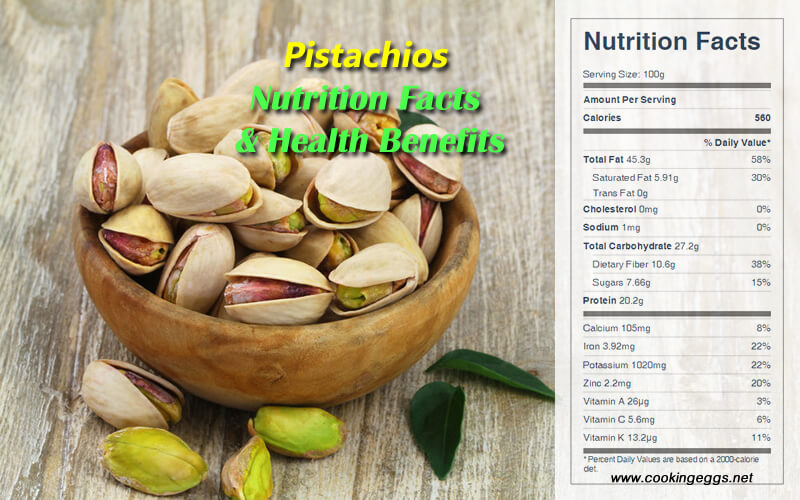Pistachio nuts Nutrition Facts & Health Benefits
Pistachios are one of the oldest edible nuts on earth. Pistachios get their name from the Greek word that translates to "the green nut". The green color of the nut is due to its chlorophyll content.
Pistachio nuts are rich in potassium, phosphorus, and magnesium, and they are also a good source of vitamin B6 and thiamine. Pistachios are similar in nutritional value to almonds, but higher in iron and vitamin B1. They are high in fiber, a good source of protein, and low in saturated fats. It’s interesting to note that the B6 in a 1-ounce serving of pistachios is equal to the B6 in a typical 3-ounce serving of chicken or pork.

The nutritional value of pistachios
Raw pistachios are 4% water, 45% fat, 28% carbohydrates, and 20% protein. In a 100-gram reference amount, pistachios provide 560 kcal of food energy and are a rich source of protein, dietary fiber, several dietary minerals, and the B vitamins thiamin (76% DV) and vitamin B6 (131% DV). Pistachios are a moderate source of calcium, riboflavin, vitamin B5, folate, vitamin E, and vitamin K.
One ounce of dry roasted pistachios (47 nuts) provides 172 calories, 7.8 g carbohydrate, 4.2 g protein, 15 g fat, 3.1 g dietary fiber, 67 IU vitamin A, 17 mcg folic acid, 275 mg potassium, 135 mg phosphorus, 20 mg calcium, and 37 mg magnesium.
The fat profile of raw pistachios consists of saturated fats, monounsaturated fats, and polyunsaturated fats. Saturated fatty acids include palmitic acid (10% of total) and stearic acid (2%). Oleic acid is the most common monounsaturated fatty acid (51% of total fat) and linoleic acid, a polyunsaturated fatty acid, is 31% of total fat. Relative to other tree nuts, pistachios have a lower amount of fat and food energy but higher amounts of potassium, vitamin K, γ-tocopherol, and certain phytochemicals such as carotenoids and phytosterols.
Pistachio nuts Nutrition Facts Label
Health Benefits of Pistachios
Pistachio fruit is a drupe containing an elongated seed, which is the edible portion. The seed, commonly thought of as a nut, is a culinary nut, not a botanical nut. The fruit has a hard, cream-colored exterior shell. The seed has a mauve-colored skin and light green flesh with a distinctive flavor.
Pistachios are loaded with fiber; you get more dietary fiber from a serving of pistachios than from a half-cup of broccoli or spinach. A sufficient amount of fiber in the diet helps in controlling cholesterol and weight loss.
Compared to other nuts, pistachios possess a lower fat content overall, while still maintaining a composition of MUFAs and PUFAs. Because they have a higher amino acid ratio than other nuts, they are a good source of vegetable protein.In addition to their macronutrient content, they also contain many vitamins and minerals, as well as carotenoids (lutein and zeaxanthin), and polyphenols (including anthocyanins, flavonoids, and proanthocyanidins).
The skin of pistachios contains resveratrol, a key ingredient being studied in the prevention of neurodegenerative diseases.
Like almonds, pistachios have great benefits as a prebiotic. Their polyphenols contribute to their uniquely high antioxidant capacity. Nuts rich in MUFAs have more antioxidant activity than PUFA-rich nuts.
Like all nuts, pistachios are particularly rich in the phytonutrients that are associated with reducing cholesterol and protecting against a variety of cancers. Studies have demonstrated a reduction in inflammatory cytokines and a rise in antioxidant enzymes. Pistachios are also high in gamma-tocopherol (a form of vitamin E), which as an antioxidant is responsible for scavenging reactive nitrogen species and acting as a COX-2 blocker. Pistachios’ antioxidant potential means they play a key role in the prevention of cancer and neurodegenerative diseases. Pistachios protect against certain forms of cancer with their high content of the potent antioxidant gamma-tocopherol.
Pistachios lubricate the intestines and tonify the kidneys and liver. A key aspect of pistachios is their ability to function as a prebiotic. Pistachios can modulate the gut by increasing the number of butyrate-producing bacteria. Butyrate is a short-chain fatty acid (SCFA) that is essential for gut bacteria to flourish. SCFAs also maintain the gut wall, stimulate the production of IgA (the security checkpoint), and boost regulatory T cells. Pistachios may also help balance inflammation and produce antioxidant potential.
Although a typical serving of pistachios supplies substantial food energy, their consumption in normal amounts is not associated with weight gain or obesity. Eating 1.5 ounces per day of most nuts, such as pistachios, as part of a diet low in saturated fat and cholesterol may reduce the risk of heart disease.
Health Risk
As with other tree seeds, aflatoxin is found in poorly harvested or processed pistachios. Aflatoxins are potent carcinogenic chemicals produced by molds such as Aspergillus flavus and Aspergillus parasiticus. It is unsafe to eat mold-infected and aflatoxin-contaminated pistachios.
Like other members of the family Anacardiaceae (which includes poison ivy, sumac, mango, and cashew), pistachios contain urushiol, an irritant that can cause allergic reactions.